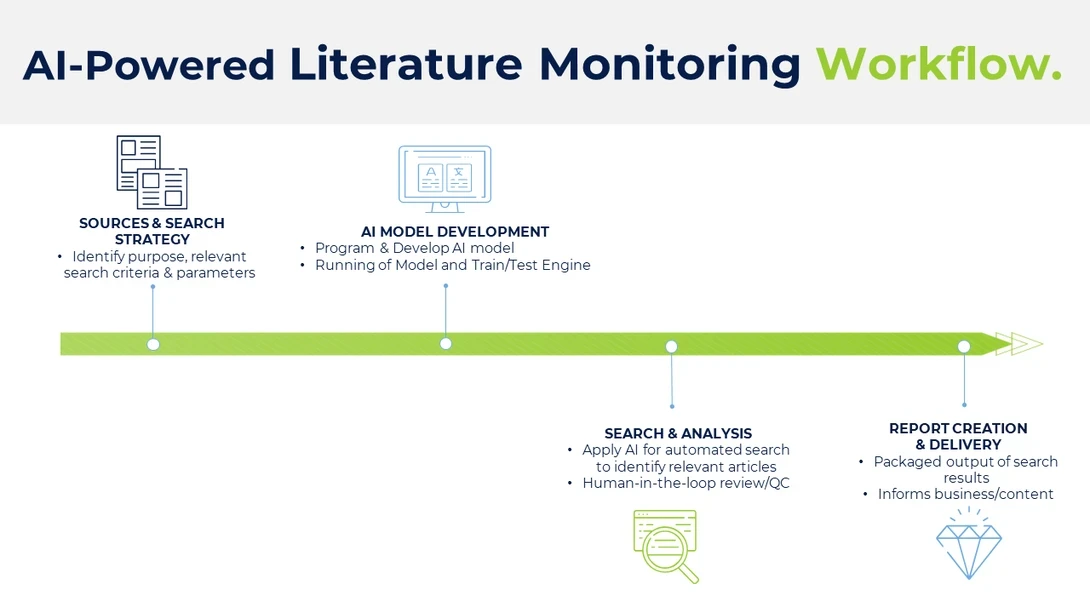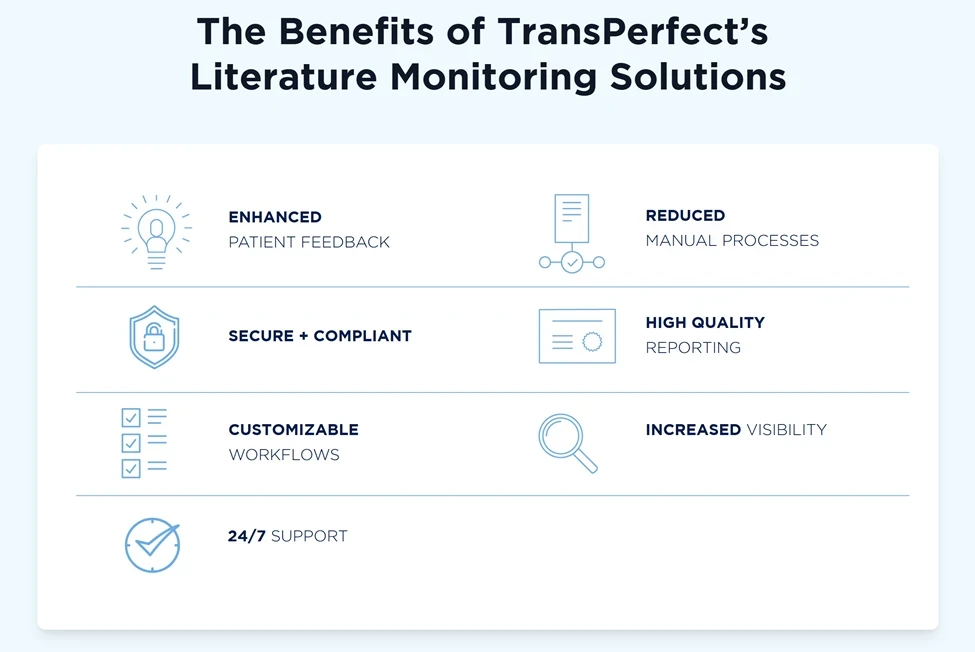AI-Powered Literature Monitoring for Medical Affairs & Medical Information Teams

Written by: Gigi Shafai, Pharm.D., Vice President, Medical Affairs & Digital Transformation, TransPerfect Life Sciences
Streamline your global literature monitoring activities and facilitate your Medical Affairs workflows and content development with AI-Powered literature monitoring
Medical Affairs and Medical Information teams are tasked with staying informed on the latest clinical research, regulatory updates, and scientific developments to make data-driven decisions. The ability to search, organize, and replicate searches of medical literature efficiently is essential for professionals in these roles.
In PubMed alone, over 1 million new citations are indexed in each year, and this is compounded over the totality of evidence available. Medical research across a variety of such sources has traditionally taken hours of labor-intensive work from medical teams for a range of purposes. The business need is clear: a more targeted and efficient search strategy is warranted to aid medical professionals.
With the rise of AI and an increased focus on using technology to ease the burden of manual work, companies have innovated and developed technological processes to support literature review across any language. Notably, given the global nature of publications, the ability to search and contextualize literature and evidence across multilingual content is essential.
Technology solutions can be used to capture data from multiple sources across digital platforms, including websites, journals, and other publications. It’s possible to set up multiple saved searches, whether for med info, to support safety teams, HEOR and publication planning, competitive intelligence, launch planning, or pipeline and study planning purposes.
By leveraging advanced AI and training engines to enhance search accuracy and speed, relevant information can be identified in the literature. Manual search and organization remain important and time-consuming tasks in medical affairs, so alleviating a step in the search helps the necessary human in the loop.
Print materials can also be scanned and combined with digital resources to create a full dataset. This content can then be analyzed and searched using AI to identify articles relevant to keywords and monitoring requirements.
Relevant materials can then be securely delivered for final review and approval through a fully auditable technology. This means that human reviewers can spend their valuable time on only relevant articles, and can develop accurate, fair, and balanced medical content more quickly and effectively. In addition, dashboards and digital sharing become important when literature monitoring output can be compliantly shared with necessary cross-functional groups.
What are some examples of scenarios where automated literature search can be applied for Medical Affairs teams?
- For medical information operations, before developing standard responses or FAQs, a comprehensive literature search is needed to identify the latest papers that contain the answer to medical questions. Consistent searches are important to replicate and conduct for standard response updates each year.
- When developing a publication plan, the current body of literature must be evaluated from a variety of lenses in order to identify gaps in the literature.
- Medical content development requires the identification of evidence-based publications for referencing and annotations.
- Identifying the most common international journals and conferences in a particular therapeutic area supports publication and conference planning efforts.
- Medical and HEOR teams need to understand the competitive landscape and learn from the growing body of literature, including study endpoints.
- Literature search is an integral part of KOL mapping, as becoming aware of prolific researchers is helpful in pipeline planning and advancing towards product launch.
- Medical Affairs teams review papers to remain subject-matter experts on the disease and treatment options for a given therapeutic area.
- AI facilitates and accelerates an enhanced understanding of disease and treatment patterns, supports research updates, and assists in detecting local, regional, or global trends.
- Text mining and extracting essential medical information from large volumes of publications save time and manual effort for medical teams.
- Automated language translations.
Local Literature Search Services
Need hands-on support? Access end-to-end language services for literature surveillance—customized to meet your specific requirements.
Support services include:
- Consultation on journal selection and keyword requirements
- Global search strategy creation and localization
- Searching across multiple structured and unstructured datasets and sources (PubMed, Embase, etc.)
- Setting up multiple searches, whether for med info or to support safety teams, HEOR and publication planning, competitive intelligence, launch planning, or pipeline and study planning purposes
- Custom automations to reduce manual monitoring and review time
- Library management/knowledge repositories populated with output from literature searching and social listening exercises
- Curation and summarization with human oversight by medical writers
- End-to-end process centralization and activity tracking

Here are five key advantages to automating your literature monitoring process:
Speed – Automating the search and review process allows for up to an 85% reduction in manual effort and time spent on monitoring, equal to saving teams around two hours per week.
Flexibility – Workflows can be customized based on local marketing requirements. This means all publications can be crawled, either at the local or international level, in any language.
Scalability – This process supports all document types and can be easily scaled across multiple country requirements and/or data sources. Whether you’re working with infrequent publications or multiple languages, it’s valuable to implement a literature search process that facilitates varying needs.
Translation Efficiency – By leveraging AI/MT, teams can eliminate the extra translation and formatting costs associated with reporting. Additionally, AI/MT delivers up to 80% accuracy, cutting down on post-editing requirements.
Tracking & Security – Your proprietary searches are secure and remain yours. Search results can be tracked and stored. When handling sensitive safety information that relates to pharmacovigilance teams and reporting workflows, it’s critical to use a 21 CFR Part 11-compliant system with full audit tracing. Implementing an automated literature search process is a crucial step to help pharma companies stay abreast of the scientific literature, especially during a time of data overload. Consider leveraging an end-to-end multilingual case processing system paired with AI and translation technology to help drive efficiency, accuracy, security, and speed for medical insights.

Selecting a Literature Monitoring Partner
Implementing effective workflows for literature monitoring begins with establishing a solid partnership with an experienced vendor who understands medical affairs operations, keyword search strategies across sources, and the cross-functional needs of companies surrounding literature.
The ideal agency partner can consult with your team to identify keyword requirements, terminologies, and search criteria to optimize search results and ensure accuracy. TransPerfect Life Sciences’ literature monitoring service enables automated local literature search and notification, increasing team efficiency. Our technology is designed to centralize literature reviews, identify required actions, and seamlessly integrate with your backend systems for easy translation management, content submission, and delivery.
It’s time to embrace and engage with technologies that can offer efficiencies to aid teams.
Want to learn how we can support your literature monitoring efforts? Contact us today!
